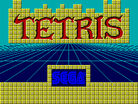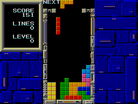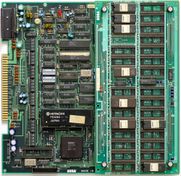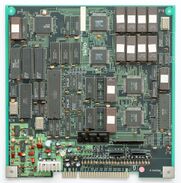Tetris (Sega): Difference between revisions
No edit summary |
|||
| (84 intermediate revisions by 20 users not shown) | |||
| Line 1: | Line 1: | ||
{{about2|the 1988 arcade version|the 1999 arcade version and its Dreamcast port|Sega Tetris}} | |||
{{Infobox |title = Tetris | {{Infobox |title = Tetris | ||
|developer = Sega | |developer = [[Sega]] | ||
|publisher = Sega | |publisher = [[Sega]] | ||
|released = 1988 | |released = December 1988 | ||
|platform = | |platform = Sega System 16B<br>Sega System 16A<br>Sega System E<br>Taito H System<br>Taito B System | ||
|boxart = Tetris_(Sega)_flyer.jpg | |||
|preview = 1 | |||
|playfield = 10 × 20 | |||
|hold = No | |||
|hard = No | |||
|system = [[Sega Rotation]] (no [[wall kick]]s) | |||
|sub-game = '''System 16 version''' | |||
{{Infobox | child=yes | decat=yes | |||
|title-scrn = SegaTetrisTitle.png | |||
|ingame-scrn = |ingame-scrn = SegaTetrisGameplay1.png | |||
}} | }} | ||
==See also== | |sub-game2 = '''System E version''' | ||
*[[ | {{Infobox | child=yes | decat=yes | ||
|title-scrn = Tetris Sega E title.PNG | |||
|ingame-scrn = Tetris Sega E screen.png | |||
}} | |||
}} | |||
'''''Tetris''''' is an arcade game published by [[Sega]] in [[1988 in Tetris|1988]]. It took Japanese arcades by storm, and is one of the most commonly known versions of the game. Due to its popularity, it became the base of rules for many other Japanese games created later on, both licensed and unlicensed. Such games include the ''[[Tetris Plus]]'' series, ''[[Tetris S]]'' , and the [[TGM series|''TGM'' series]]. It was one of the first games to have [[lock delay]], greatly improving maneuverability at high speeds. | |||
== Gameplay == | |||
Sega's version of ''Tetris'' is an endless game with the only goal being to score points. As the player progresses, the levels increase thereby changing the game speed. Highly skilled players can play indefinitely, even when the score [[maxout|counter stops]] at 999,999 points, though players usually stop once this is achieved. | |||
Being an early game, released just one year after [[Elorg]] licensed ''Tetris'' to publishers, [[tetromino]]es can only be rotated counterclockwise. Unlike these games however, this version has 3 buttons which can be tapped quickly in a piano-like motion, equivalent to a clockwise rotation. | |||
It did not implement [[wall kick]]s or [[hard drop]]. However, many of the mechanics that exist in later games were first seen in this version, such as 1G [[DAS]] movement, lock delay, [[ARE]], and rotation/movement processed before gravity—allowing for [[TGM legend#Synchro|synchro]] moves to be performed at 1G fall speed. | |||
A game design element not commonly seen in recent games is the existence of a [[ceiling]]. The [[playfield]] height is 20 rows, and any rotation that would exceed that height will fail. At high gravity speeds, players must time their piece rotations so the piece is not touching the ceiling, and also not stuck in the stack. | |||
=== Gameplay details === | |||
* [[Drop#Soft drop|Soft drop]]: 1G | |||
* [[Lock delay]]: 30 frames | |||
* [[ARE]]: 30 frames | |||
* [[Line clear#Delay|Line clear delay]]: 42 frames | |||
* [[DAS]]: 20 frames | |||
=== Speed levels === | |||
There are four difficulties which affect the speed, easy, normal, hard and hardest. The game difficulty can be configured through the DIP switch on the arcade board. | |||
[[Image:Sega_speed_graph.png|thumb|none|500px|Graph of gravity timings per level]] | |||
{| class="wikitable mw-collapsible mw-collapsed" | |||
|+ style="white-space: nowrap;" | Fall speed table; frames per cell | |||
!Level||Easy||Normal||Hard||Hardest | |||
|- | |||
| 0||48||48||40||30 | |||
|- | |||
| 1||32||24||20||15 | |||
|- | |||
| 2||24||18||16||12 | |||
|- | |||
| 3||18||15||12||10 | |||
|- | |||
| 4||14||12||10|| 8 | |||
|- | |||
| 5||12||10|| 8|| 6 | |||
|- | |||
| 6||10|| 8|| 6|| 4 | |||
|- | |||
| 7|| 8|| 6|| 4|| 2 | |||
|- | |||
| 8|| 6|| 4|| 2|| 1 | |||
|- | |||
| 9|| 4|| 2|| 1|| 1 | |||
|- | |||
|10||12||10||10|| 8 | |||
|- | |||
|11||10|| 8|| 8|| 6 | |||
|- | |||
|12|| 8|| 6|| 6|| 4 | |||
|- | |||
|13|| 6|| 4|| 4|| 2 | |||
|- | |||
|14|| 4|| 2|| 2|| 1 | |||
|- | |||
|15|| 2|| 1|| 1|| 1 | |||
|} | |||
=== Level advancement requirements === | |||
There are two ways to increase the level: | |||
* Clear 4 lines in any combination of [[line clear]]s. (When a tetromino is locked and clears any lines.) | |||
* Place a tetromino after the "level timer" reaches a certain value. (When a tetromino is locked and clears no line.) | |||
The level timer increases every frame, except when reset after level-up. | |||
{| class="wikitable" | |||
|+ Level timer per level | |||
! Level | |||
| 0 || 1-8 || 9-10 ||11-14 ||15-99 | |||
|- | |||
! Required time (frames) | |||
| 3480 || 2320 || 3480 || 1740 || 3480 | |||
|- | |||
! Required time (Seconds) | |||
| 58 || 38.67 || 58 || 29 || 58 | |||
|- | |||
|} | |||
Level 15 value is used for levels 16 to 99. | |||
A TAS for Sega's ''Tetris'' abuses lock delay and step reset to keep pieces active until the level timer expires, to level up as much as possible with the fewest lines cleared. At a higher level the points awarded from line clears is greater, thus needing fewer total lines to achieve a maxout.<ref>[https://www.nicovideo.jp/watch/sm10007315 (TAS) Sega Tetris maxout in 98 lines]</ref> | |||
<br clear="all"> | |||
=== Scoring === | |||
{| class="wikitable" | |||
! Level | |||
! Points for<br>1 line || Points for<br>2 lines || Points for<br>3 lines || Points for<br>4 lines || Points for soft dropping pieces | |||
|- | |||
| 0-1 || 100 || 400 || 900 || 2000 || 1 per line | |||
|- | |||
| 2-3 || 200 || 800 || 1800 || 4000 || 2 per line | |||
|- | |||
| 4-5 || 300 || 1200 || 2700 || 6000 || 3 per line | |||
|- | |||
| 6-7 || 400 || 1600 || 3600 || 8000 || 4 per line | |||
|- | |||
| 8+ || 500 || 2000 || 4500 || 10000 || 5 per line | |||
|} | |||
If a line clear is also a Perfect Clear, a 10x multiplier is applied to the awarded points. | |||
=== Notes === | |||
* Current piece fall speed is located at <code>C7000Ah</code> in the RAM. | |||
* Current level timer is located at <code>C72336h</code> (word) in RAM in System 16A version; <code>FFE336h</code> in System 16B version. This table is located at <code>3D28</code> in the 68k portion of an unshuffled ROM for System 16B version. | |||
==Power-on Pattern== | |||
{{main|Power-on pattern}} | |||
One characteristic of this version of ''Tetris'' was the existence of a Power-on pattern. This referred to the game's behavior that the string of pieces it dealt in the very first game after starting up the system was always the same. This was most probably caused by the state of the randomization seed in the system. After its discovery, players began constructing gameplay plans around the power-on pattern in order to max out the score in the least lines possible. ''[[Sega Tetris]]'' (1999, Arcade, Dreamcast) pays tribute to the power-on pattern, by dealing the sequence in the final level of the single-player game. ''[[Tetris S]]'' also contains the pattern. | |||
For MAME players, unless you are playing the bootleg, you must delete your NVRAM before playing to get the power-on pattern. The B-system version has a different power-on pattern, and does not require you to delete your NVRAM. It even restores the pattern upon reset, which not even the bootleg will do. The System E version does not have a power-on pattern. <!-- check H-system --> | |||
== Other versions == | |||
===System E version === | |||
With the initial System 16 release being a significant success, Sega also released a version for their System E arcade board, which was based on the 8-bit hardware of the Sega Master System console. | |||
=== Taito versions === | |||
Because of the popularity of Tetris in Japan at the time, Taito repurposed some of their less-popular arcade cabinets with Tetris. These cabinets were found in Taito-owned arcade locations. | |||
Three versions were made: | |||
* B-System (YM-2203): ''Master of Weapon'' conversion | |||
* B-System (YM-2610): ''Rastan Saga II'' conversion | |||
* H-System: ''Go for the Gold'' conversion | |||
All are visually identical to the System 16 version, as the Taito boards were similar in specification. | |||
Gameplay details: | |||
* [[Drop#Soft drop|Soft drop]]: 1G | |||
* [[Lock delay]]: 30 frames | |||
* [[ARE]]: 30 frames | |||
* [[Line clear#Delay|Line clear delay]]: 42 frames | |||
* [[DAS]]: 21 frames | |||
Level advancement requirements: | |||
There are two ways to increase the level: | |||
* Clear 4 lines in any combination of [[line clear]]s. | |||
* Clear any lines after the "level timer" reaches a certain value. | |||
The level timer stops during ARE. | |||
{| class="wikitable" | |||
|+ Level timer per level | |||
! Level | |||
| 0 || 1-8 || 9-10 ||11-14 ||15-99 | |||
|- | |||
! Required time (frames) | |||
| 3600 || 2400 || 3600 || 1800 || 3600 | |||
|- | |||
! Required time (Seconds) | |||
| 60 || 40 || 60 || 30 || 60 | |||
|- | |||
|} | |||
The person responsible for porting the game to the H-System leaked to 2ch that he had hidden cheat codes within the game.<ref>[https://web.archive.org/web/20100107090540/http://dubai.2ch.net:80/test/read.cgi/rarc/1231360670 Internet Archive (from 257 to 298)]</ref> | |||
Codes on H-System: | |||
#Wait "How to play" screen starts with "CREDIT 0". | |||
#Input a code (see below) before "How to play" screen ends. | |||
#Add necessary credit(s). | |||
#Wait "Iguana" screen starts. | |||
#Push "1P START" before "Iguana" screen ends. | |||
1=1P UP ON / 3=1P DOWN ON / 5=1P LEFT ON / 7=1P RIGHT ON / 9=1P ROTATE ON<br> | |||
2=2P UP ON / 4=2P DOWN ON / 6=2P LEFT ON / 8=2P RIGHT ON / 10=2P ROTATE ON<br> | |||
11=1P UP OFF / 13=1P DOWN OFF / 15=1P LEFT OFF / 17=1P RIGHT OFF / 19=1P ROTATE OFF<br> | |||
12=2P UP OFF / 14=2P DOWN OFF / 16=2P LEFT OFF / 18=2P RIGHT OFF / 20=2P ROTATE OFF<br> | |||
{| class="wikitable" | |||
!ID | |||
!Codes | |||
!Necessary<br>credit(s) | |||
|- | |||
!rowspan="2"|A | |||
|9, 19, 10, 9, 19, 20, 5, 8, 15, 9, 19, 18 | |||
|(3) | |||
|- | |||
|colspan="2"|Only "I" tetromino | |||
|- | |||
!rowspan="2"|B | |||
|9, 19, 10, 20, 10, 20, 10, 20, 10, 20, 10, 20 | |||
|(1) | |||
|- | |||
|colspan="2"|Never "I" tetromino | |||
|- | |||
!rowspan="2"|C | |||
|4, 9, 1, 10, 20, 11, 14, 19, 2, 1, 11, 12 | |||
|(3) | |||
|- | |||
|colspan="2"|Allow to move up | |||
|- | |||
!rowspan="2"|D | |||
|3, 13, 3, 13, 1, 11, 4, 14, 4, 14, 9, 19 | |||
|(2) | |||
|- | |||
|colspan="2"|Fake next tetromino | |||
|- | |||
!rowspan="2"|E | |||
|1, 11, 3, 13, 1, 11, 3, 13, 2, 12, 2, 12 | |||
|(2) | |||
|- | |||
|colspan="2"|Rotate clockwise | |||
|- | |||
!rowspan="2"|F | |||
|7, 17, 7, 17, 7, 17, 7, 17, 7, 17, 7, 17 | |||
|(1) | |||
|- | |||
|colspan="2"|Four digits Line counter | |||
|- | |||
!rowspan="2"|G | |||
|4, 14, 9, 10, 19, 20, 9, 10, 5, 15, 20, 19 | |||
|(3) | |||
|- | |||
|colspan="2"|Another color tetromino | |||
|- | |||
!rowspan="2"|H | |||
|5, 15, 5, 15, 6, 16, 6, 16, 4, 1, 14, 11 | |||
|(2) | |||
|- | |||
|colspan="2"|Only "S" or "Z" tetromino | |||
|- | |||
!rowspan="2"|I | |||
|5, 15, 5, 15, 5, 15, 5, 15, 5, 15, 7, 17 | |||
|(1) | |||
|- | |||
|colspan="2"|Fastest | |||
|- | |||
!rowspan="2"|J | |||
|9, 10, 5, 8, 19, 20, 18, 15, 9, 19, 5, 15 | |||
|(3) | |||
|- | |||
|colspan="2"|Another sound effect | |||
|- | |||
!rowspan="2"|K | |||
|9, 19, 5, 4, 9, 19, 10, 20, 14, 15, 5, 15 | |||
|(3) | |||
|- | |||
|colspan="2"|Another monkey | |||
|- | |||
!rowspan="2"|L | |||
|9, 19, 9, 19, 5, 15, 3, 13, 3, 4, 13, 14 | |||
|(3) | |||
|- | |||
|colspan="2"|All clear picture type 1 | |||
|- | |||
!rowspan="2"|M | |||
|10, 20, 10, 20, 6, 16, 4, 14, 4, 3, 14, 13 | |||
|(3) | |||
|- | |||
|colspan="2"|All clear picture type 2 | |||
|- | |||
!rowspan="2"|N | |||
|10, 20, 10, 20, 8, 18, 2, 12, 2, 1, 12, 11 | |||
|(3) | |||
|- | |||
|colspan="2"|All clear picture type 3 | |||
|- | |||
!rowspan="2"|O | |||
|9, 19, 9, 19, 9, 19, 9, 19, 9, 19, 10, 20 | |||
|(1) | |||
|- | |||
|colspan="2"|See difficulty DIP SW | |||
|- | |||
|} | |||
== Legacy == | |||
[[Image:Japanese_Man_Playing_Tetris.jpg|200px|thumb|right|Japanese man playing ''Tetris'' (Sega)]] | |||
This game remains to this day significant in Japan and other eastern Asian countries. Its gameplay, music, and many of the aesthetics were adapted in ''[[Tetris S]]'' and ''[[Sega Tetris]]''. It has influenced many other Tetris games developed in Japan, including ''[[Tetris Plus]]'' and the [[TGM series]]. | |||
The game was re-released as part of Sega's [[Sega_Ages_2500_Series_Vol.28_Tetris_Collection|Tetris Collection]] for the PlayStation 2, along with other early Sega Tetris titles. The Mega Drive Mini also includes a port of this game with a few more options, instead of the unreleased [[Tetris (Mega Drive)|Mega Drive version]]. | |||
== Physical scans == | |||
{{Scanbox | |||
|console = Sega System 16B | |||
|region = JP | |||
|pcb = Tetris (Sega) System 16B arcade PCB.jpg | |||
|dimensions = 300×290×38 mm | |||
}} | |||
{{Scanbox | |||
|console = Taito H-System | |||
|region = JP | |||
|pcb = Tetris (Sega) H-System arcade PCB.jpg | |||
}} | |||
== See also == | |||
* [[Sega Ages 2500 Series Vol.28 Tetris Collection]] - This collection featured a port of ''Tetris'' (Sega) as one of its playable titles with a few extra gameplay options. | |||
* [[Tetris (Sega) Techniques]] | |||
== References == | |||
<references /> | |||
{{Sega games}} | |||
[[Category:Official Tetris games]] | |||
[[Category:Arcade games]] | |||
Latest revision as of 06:47, 11 May 2023
- This article is about the 1988 arcade version. For the 1999 arcade version and its Dreamcast port, see Sega Tetris.
| Tetris | |
|---|---|
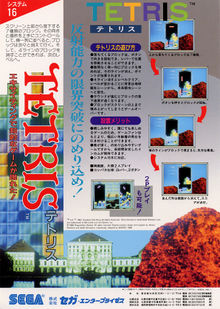 | |
| Developer(s) | Sega |
| Publisher(s) | Sega |
| Platform(s) | Sega System 16B Sega System 16A Sega System E Taito H System Taito B System |
| Release | December 1988 |
| Gameplay info | |
| Next pieces | 1 |
| Playfield size | 10 × 20 |
| Hold piece | No |
| Hard drop | No |
| Rotation system | Sega Rotation (no wall kicks) |
| System 16 version | |
| System E version | |
Tetris is an arcade game published by Sega in 1988. It took Japanese arcades by storm, and is one of the most commonly known versions of the game. Due to its popularity, it became the base of rules for many other Japanese games created later on, both licensed and unlicensed. Such games include the Tetris Plus series, Tetris S , and the TGM series. It was one of the first games to have lock delay, greatly improving maneuverability at high speeds.
Gameplay
Sega's version of Tetris is an endless game with the only goal being to score points. As the player progresses, the levels increase thereby changing the game speed. Highly skilled players can play indefinitely, even when the score counter stops at 999,999 points, though players usually stop once this is achieved.
Being an early game, released just one year after Elorg licensed Tetris to publishers, tetrominoes can only be rotated counterclockwise. Unlike these games however, this version has 3 buttons which can be tapped quickly in a piano-like motion, equivalent to a clockwise rotation.
It did not implement wall kicks or hard drop. However, many of the mechanics that exist in later games were first seen in this version, such as 1G DAS movement, lock delay, ARE, and rotation/movement processed before gravity—allowing for synchro moves to be performed at 1G fall speed.
A game design element not commonly seen in recent games is the existence of a ceiling. The playfield height is 20 rows, and any rotation that would exceed that height will fail. At high gravity speeds, players must time their piece rotations so the piece is not touching the ceiling, and also not stuck in the stack.
Gameplay details
- Soft drop: 1G
- Lock delay: 30 frames
- ARE: 30 frames
- Line clear delay: 42 frames
- DAS: 20 frames
Speed levels
There are four difficulties which affect the speed, easy, normal, hard and hardest. The game difficulty can be configured through the DIP switch on the arcade board.
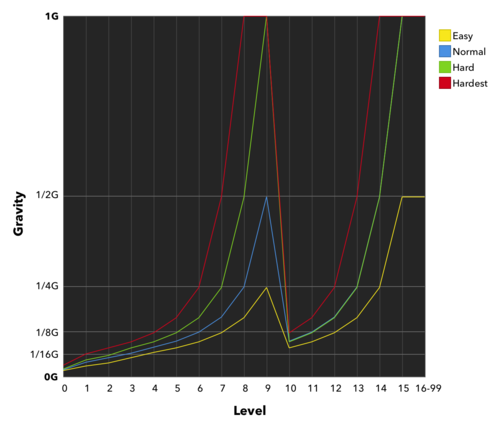
| Level | Easy | Normal | Hard | Hardest |
|---|---|---|---|---|
| 0 | 48 | 48 | 40 | 30 |
| 1 | 32 | 24 | 20 | 15 |
| 2 | 24 | 18 | 16 | 12 |
| 3 | 18 | 15 | 12 | 10 |
| 4 | 14 | 12 | 10 | 8 |
| 5 | 12 | 10 | 8 | 6 |
| 6 | 10 | 8 | 6 | 4 |
| 7 | 8 | 6 | 4 | 2 |
| 8 | 6 | 4 | 2 | 1 |
| 9 | 4 | 2 | 1 | 1 |
| 10 | 12 | 10 | 10 | 8 |
| 11 | 10 | 8 | 8 | 6 |
| 12 | 8 | 6 | 6 | 4 |
| 13 | 6 | 4 | 4 | 2 |
| 14 | 4 | 2 | 2 | 1 |
| 15 | 2 | 1 | 1 | 1 |
Level advancement requirements
There are two ways to increase the level:
- Clear 4 lines in any combination of line clears. (When a tetromino is locked and clears any lines.)
- Place a tetromino after the "level timer" reaches a certain value. (When a tetromino is locked and clears no line.)
The level timer increases every frame, except when reset after level-up.
| Level | 0 | 1-8 | 9-10 | 11-14 | 15-99 |
|---|---|---|---|---|---|
| Required time (frames) | 3480 | 2320 | 3480 | 1740 | 3480 |
| Required time (Seconds) | 58 | 38.67 | 58 | 29 | 58 |
Level 15 value is used for levels 16 to 99.
A TAS for Sega's Tetris abuses lock delay and step reset to keep pieces active until the level timer expires, to level up as much as possible with the fewest lines cleared. At a higher level the points awarded from line clears is greater, thus needing fewer total lines to achieve a maxout.[1]
Scoring
| Level | Points for 1 line |
Points for 2 lines |
Points for 3 lines |
Points for 4 lines |
Points for soft dropping pieces |
|---|---|---|---|---|---|
| 0-1 | 100 | 400 | 900 | 2000 | 1 per line |
| 2-3 | 200 | 800 | 1800 | 4000 | 2 per line |
| 4-5 | 300 | 1200 | 2700 | 6000 | 3 per line |
| 6-7 | 400 | 1600 | 3600 | 8000 | 4 per line |
| 8+ | 500 | 2000 | 4500 | 10000 | 5 per line |
If a line clear is also a Perfect Clear, a 10x multiplier is applied to the awarded points.
Notes
- Current piece fall speed is located at
C7000Ahin the RAM. - Current level timer is located at
C72336h(word) in RAM in System 16A version;FFE336hin System 16B version. This table is located at3D28in the 68k portion of an unshuffled ROM for System 16B version.
Power-on Pattern
- Main article: Power-on pattern
One characteristic of this version of Tetris was the existence of a Power-on pattern. This referred to the game's behavior that the string of pieces it dealt in the very first game after starting up the system was always the same. This was most probably caused by the state of the randomization seed in the system. After its discovery, players began constructing gameplay plans around the power-on pattern in order to max out the score in the least lines possible. Sega Tetris (1999, Arcade, Dreamcast) pays tribute to the power-on pattern, by dealing the sequence in the final level of the single-player game. Tetris S also contains the pattern.
For MAME players, unless you are playing the bootleg, you must delete your NVRAM before playing to get the power-on pattern. The B-system version has a different power-on pattern, and does not require you to delete your NVRAM. It even restores the pattern upon reset, which not even the bootleg will do. The System E version does not have a power-on pattern.
Other versions
System E version
With the initial System 16 release being a significant success, Sega also released a version for their System E arcade board, which was based on the 8-bit hardware of the Sega Master System console.
Taito versions
Because of the popularity of Tetris in Japan at the time, Taito repurposed some of their less-popular arcade cabinets with Tetris. These cabinets were found in Taito-owned arcade locations.
Three versions were made:
- B-System (YM-2203): Master of Weapon conversion
- B-System (YM-2610): Rastan Saga II conversion
- H-System: Go for the Gold conversion
All are visually identical to the System 16 version, as the Taito boards were similar in specification.
Gameplay details:
- Soft drop: 1G
- Lock delay: 30 frames
- ARE: 30 frames
- Line clear delay: 42 frames
- DAS: 21 frames
Level advancement requirements: There are two ways to increase the level:
- Clear 4 lines in any combination of line clears.
- Clear any lines after the "level timer" reaches a certain value.
The level timer stops during ARE.
| Level | 0 | 1-8 | 9-10 | 11-14 | 15-99 |
|---|---|---|---|---|---|
| Required time (frames) | 3600 | 2400 | 3600 | 1800 | 3600 |
| Required time (Seconds) | 60 | 40 | 60 | 30 | 60 |
The person responsible for porting the game to the H-System leaked to 2ch that he had hidden cheat codes within the game.[2]
Codes on H-System:
- Wait "How to play" screen starts with "CREDIT 0".
- Input a code (see below) before "How to play" screen ends.
- Add necessary credit(s).
- Wait "Iguana" screen starts.
- Push "1P START" before "Iguana" screen ends.
1=1P UP ON / 3=1P DOWN ON / 5=1P LEFT ON / 7=1P RIGHT ON / 9=1P ROTATE ON
2=2P UP ON / 4=2P DOWN ON / 6=2P LEFT ON / 8=2P RIGHT ON / 10=2P ROTATE ON
11=1P UP OFF / 13=1P DOWN OFF / 15=1P LEFT OFF / 17=1P RIGHT OFF / 19=1P ROTATE OFF
12=2P UP OFF / 14=2P DOWN OFF / 16=2P LEFT OFF / 18=2P RIGHT OFF / 20=2P ROTATE OFF
| ID | Codes | Necessary credit(s) |
|---|---|---|
| A | 9, 19, 10, 9, 19, 20, 5, 8, 15, 9, 19, 18 | (3) |
| Only "I" tetromino | ||
| B | 9, 19, 10, 20, 10, 20, 10, 20, 10, 20, 10, 20 | (1) |
| Never "I" tetromino | ||
| C | 4, 9, 1, 10, 20, 11, 14, 19, 2, 1, 11, 12 | (3) |
| Allow to move up | ||
| D | 3, 13, 3, 13, 1, 11, 4, 14, 4, 14, 9, 19 | (2) |
| Fake next tetromino | ||
| E | 1, 11, 3, 13, 1, 11, 3, 13, 2, 12, 2, 12 | (2) |
| Rotate clockwise | ||
| F | 7, 17, 7, 17, 7, 17, 7, 17, 7, 17, 7, 17 | (1) |
| Four digits Line counter | ||
| G | 4, 14, 9, 10, 19, 20, 9, 10, 5, 15, 20, 19 | (3) |
| Another color tetromino | ||
| H | 5, 15, 5, 15, 6, 16, 6, 16, 4, 1, 14, 11 | (2) |
| Only "S" or "Z" tetromino | ||
| I | 5, 15, 5, 15, 5, 15, 5, 15, 5, 15, 7, 17 | (1) |
| Fastest | ||
| J | 9, 10, 5, 8, 19, 20, 18, 15, 9, 19, 5, 15 | (3) |
| Another sound effect | ||
| K | 9, 19, 5, 4, 9, 19, 10, 20, 14, 15, 5, 15 | (3) |
| Another monkey | ||
| L | 9, 19, 9, 19, 5, 15, 3, 13, 3, 4, 13, 14 | (3) |
| All clear picture type 1 | ||
| M | 10, 20, 10, 20, 6, 16, 4, 14, 4, 3, 14, 13 | (3) |
| All clear picture type 2 | ||
| N | 10, 20, 10, 20, 8, 18, 2, 12, 2, 1, 12, 11 | (3) |
| All clear picture type 3 | ||
| O | 9, 19, 9, 19, 9, 19, 9, 19, 9, 19, 10, 20 | (1) |
| See difficulty DIP SW | ||
Legacy

This game remains to this day significant in Japan and other eastern Asian countries. Its gameplay, music, and many of the aesthetics were adapted in Tetris S and Sega Tetris. It has influenced many other Tetris games developed in Japan, including Tetris Plus and the TGM series.
The game was re-released as part of Sega's Tetris Collection for the PlayStation 2, along with other early Sega Tetris titles. The Mega Drive Mini also includes a port of this game with a few more options, instead of the unreleased Mega Drive version.
Physical scans
See also
- Sega Ages 2500 Series Vol.28 Tetris Collection - This collection featured a port of Tetris (Sega) as one of its playable titles with a few extra gameplay options.
- Tetris (Sega) Techniques
References
| |||||||||||


